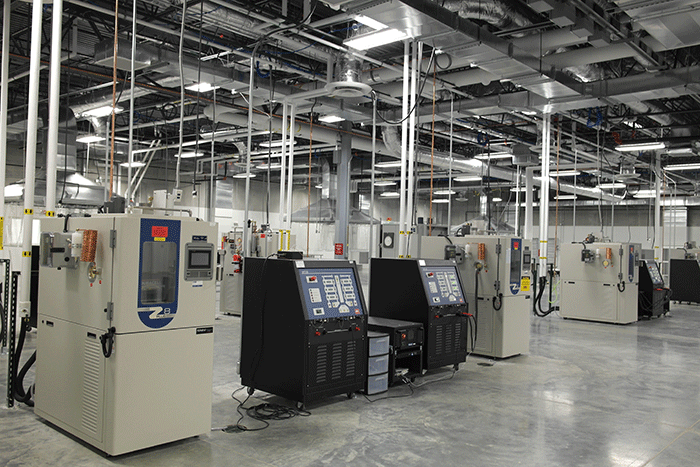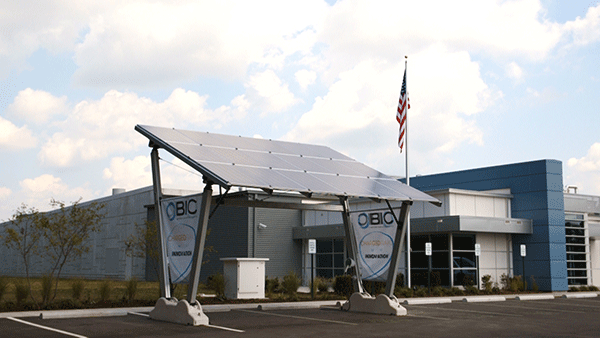Liza Wormus, Media and Communications Specialist
Cincinnati Sub-Zero Products, Inc.
During the past 10 years, we have seen an incredible surge in the demand for advanced battery technologies. One of the major factors in this growth is the need for green energy to reduce emissions and help the environment. After the introduction of hybrid vehicles, and because of the increasing popularity of electric vehicles, the demand for batteries that keep a charge longer, while still being reliable and use less energy has skyrocketed. We have also seen this growth from the electronics and medical sector, where a need for batteries that will power cell phones, tablets and other electronic devices has dramatically increased.
 As a result of this growth, the Battery Innovation Center (BIC), a non-profit organization located in Indiana was formed. They opened their 32,000 square foot facility in August of 2013, it serves as a hub for the developing, commercializing and validating of high-tech battery technologies. The Battery Innovation Center desires to accelerate new technologies, act as an industry focal point for battery innovation and to be a trusted source of energy storage capabilities.
As a result of this growth, the Battery Innovation Center (BIC), a non-profit organization located in Indiana was formed. They opened their 32,000 square foot facility in August of 2013, it serves as a hub for the developing, commercializing and validating of high-tech battery technologies. The Battery Innovation Center desires to accelerate new technologies, act as an industry focal point for battery innovation and to be a trusted source of energy storage capabilities.
BIC is funded through partnerships with academia, government agencies and companies specializing in technology, engineering, sustainability, research, energy and power. These members not only benefit from the tools and technology located at the Indiana facility, but also from the vast array of facilities and capabilities located at participating universities as well as the NSWC Crane Division. Additionally, there is an ability to partner with other members on projects, leveraging a variety of technical skills and capabilities, which will result in accelerated advancements in battery technologies.
Facility
The facilities at the Battery Innovation Center provide the equipment for the designing, fabricating, packaging and testing of new energy storage systems. All of the equipment at the Battery Innovation Center is installed with safety systems to help mitigate the risks associated with the development and testing of batteries.
Development & Manufacturing
Cell, battery pack development and manufacturing are key to the acceleration of new technologies in energy storage. At the Battery Innovation Center, members are able to develop and manufacture both cylindrical and prismatic battery designs that possess structural integrity and durability. The BIC can support 300 cells a month with tools for mixing, coating, cutting, stacking, winding, formation, packaging and more. They also have a film line with a dryer, a dry room and a laser lab. Also, because of the special partnership with NSWC Crane, there is direct interface to NSWC Crane printed circuit board development and manufacturing which is Mil-Std compliant.
MicroGrid
The Battery Innovation Center utilizes and strives to develop MicroGrid capabilities, the facility is currently designed with access to more than 6 MW of power and contains a large grid storage device of approximately 1 MW. For green energy, BIC has low velocity, high efficiency wind turbines and a solar array with capabilities for electric vehicle charging, as well as regenerative charging systems for low-impact energy consumption.
Testing
 The Battery Innovation Center also has testing capabilities, which is important because of the many risks associated with batteries. Common failures associated with batteries include overcharging, undercharging, overheating or a crack in the separating membrane. These failures can result in rupture, fire or an explosion. To minimize this risk, there are UL, IEC, SAE and IEEE testing specifications to be sure that the batteries will endure their everyday environment. While The Battery Innovation Center does not perform “test to fail” services. All batteries being tested in the center must first be certified as “safe” by a lab designed to do abuse testing, such as NSWC Crane, with whom the BIC has a Cooperative Research and Development Agreement to do such tests.
The Battery Innovation Center also has testing capabilities, which is important because of the many risks associated with batteries. Common failures associated with batteries include overcharging, undercharging, overheating or a crack in the separating membrane. These failures can result in rupture, fire or an explosion. To minimize this risk, there are UL, IEC, SAE and IEEE testing specifications to be sure that the batteries will endure their everyday environment. While The Battery Innovation Center does not perform “test to fail” services. All batteries being tested in the center must first be certified as “safe” by a lab designed to do abuse testing, such as NSWC Crane, with whom the BIC has a Cooperative Research and Development Agreement to do such tests.
BIC approached Cincinnati Sub-Zero (CSZ), an industry leader in supplying environmental test chambers to the battery industry with more than 70 years of experience in designing and manufacturing temperature-humidity controlled products. CSZ’s experience with battery testing chambers spans across a variety of industries, including automotive, computer, telecommunications, defense, medical and alternative energy markets. The Battery Innovation Center’s need was to purchase chambers that would be specially designed for battery testing, with the design taking into consideration the risks involved and they found that CSZ’s experience was a perfect fit.
 Onsite, the Battery Innovation Center has nine Cincinnati Sub-Zero test chambers, eight of them being temperature chambers, one with humidity, along with a unique temperature & altitude chamber for combined environmental testing.
Onsite, the Battery Innovation Center has nine Cincinnati Sub-Zero test chambers, eight of them being temperature chambers, one with humidity, along with a unique temperature & altitude chamber for combined environmental testing.
In order to mitigate the risk of testing batteries, each of these chambers are equipped with safety features and controls specially designed for battery testing. The most common features used in environmental chambers for battery testing are temperature limited sheath heaters. The goal of sheath heaters is to control the temperature of the heater to allow the chamber to meet the desired air temperature while staying below the auto-ignition point. Another major feature in chambers for battery testing is the capability for pressure compensation, which allows the chamber to breathe and account for the expanding air within the workspace.
The temperature chambers are equipped with explosion pressure relief ports and the altitude chamber is equipped with two pressure rated rupture discs, each of these will allow for pressure relief in case the test article fails. These chambers are also equipped with a H2 and CO2 gas monitor and alarm, a programmable door lock and a CO2 fire suppression system, for added safety. The BIC is also equipped with a multi-layer full-lab fire suppression system, as well as a ventilation system designed to cycle the air 100 percent roughly every four minutes.
Projects
Currently, the Battery Innovation Center is working on multiple partnership projects. These include joint projects to design, manufacture and test lithium ion cells, and a joint project to develop and test large battery capabilities for MicroGrids. Another project will partner with Purdue University to deliver a Master’s Degree program in Energy Storage Systems. Ivy Tech University is currently in the lab teaching its Electrical Engineering Technologies (EET) associates and masters programs. The Battery Innovation Center has just released its Request for Proposals (available on the BIC’s website) for the development of new energy storage systems. The Center will invest $2 million in two to four projects chosen from these proposals. The deadline for submission is January 3, 2014.
The goal of the Battery Innovation Center is to accelerate the commercialization of new battery technologies. Charles LaSota, president & CEO of BIC, describes “energy storage devices as technology enablers.” As new technology and electronics emerge, one of the major influences to their success is the reliability and performance of the battery associated with it, making organizations like the Battery Innovation Center imperative to technology development. BIC is currently accepting new members and if you would like more information, please visit www.bicindiana.com.
About the Battery Innovation Center
The Battery Innovation Center (BIC) project is a collaborative initiative designed to incorporate leadership from renowned universities, government agencies and commercial enterprises to focus on the rapid development, testing and commercialization of safe, reliable and lightweight energy storage systems for defense and commercial customers.
About Cincinnati Sub-Zero
CSZ provides standard & custom-designed environmental test chambers including temperature-cycling chambers, humidity chambers, accelerated stress-testing chambers, HALT & HASS chambers, thermal-shock chambers, altitude chambers, AGREE vibration chambers and more. Sizes range from small bench-top chambers to full walk-in / drive –in rooms.
For more information, contact Charles LaSota,
Charles.LaSota@BICIndiana.com or visit www.bicindiana.com.
Please visit www.cszindustrial.com for additional information.







